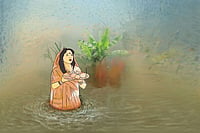World of Nagraj, Chacha Chaudhary and Single Screen Theatres
Remember Super Commando Dhruv or Chacha Chaudhary? And of course Sabu who came from Jupiter and each time he’d get angry, a volcanic eruption would happen on faraway Jupiter? These super heroes were our desi versions of Superman and Spider-Man. In the 1980s, in the Hindi heartland, you had mini libraries where you could borrow a comic book for Re 1. I remember summer afternoons spent reading about the adventures of Nagraj who had all these snakes embedded in his being and he was a saviour.
These comics were very integral to our growing up and in these alternative worlds, we found hope and courage to take on everything and become a superhero because their powers were specific and matched our contexts. Nostalgia is not an indulgence but a way to find ourselves, too. In little episodes, in these books we read and in the literature that was available then. There were also these magazines like Nandan, Nanhe Samrat, Suman Saurabh, and Champak which we looked forward to reading every month. We were people who had patience, who waited for stories. Never in a hurry. Always for savouring everything. Mayapuri, the Hindi Bollywood magazine, was our window to the world of Maya Nagri (Bollywood), and we got all our Bollywood gossip in its pages. The magazine also published the addresses of film-stars back then and sometimes we even sent inland letters professing our love to the stars we adored like Divya Bharti and Sridevi and Anil Kapoor. We always hoped for a reply but it never came. That didn’t deter us. We didn’t take things personally. The stars were out there. Out of reach. We saw them, loved them. We were content with our one-sided adoration.
And then, there were magazines like Manohar Kahaniyan which had all these crime and black magic stories and we hid them inside the newspaper and read the grilling stories cantered around crime, sex and love.
C and I are from the same state but we had different childhoods. She lived in a city and went to an English medium school where she was exposed to a lot more, like Enid Blyton and English comics, but like me, she also had her favourite Indian superheroes. R and I were VMTs (vernacular medium types) who had almost nil exposure to the foreign superheroes or magazines or novels. A lot changed later but I remember how in one comic series by Raj Comics, all superheroes came together to fight evil.
C remembers that one. She always found Nagraj very noble and brave.

These memories of those times are precious to us. We are now living in abundant times where everything is so accessible and so dispensable. The joy is certainly not as much as it used to be when we went to watch films in those single screen theatres.
My hometown had three, of which one shut down while we were still there and that I think was the beginning of the endings of many things. Growing up, we never had the same day release and the films that were big hits would reach Saharsa after at least three months. Perhaps it was very expensive to distribute and exhibit a film everywhere on the day of the release. We still don’t have a multiplex in my hometown, but C says the single screens in Patna have now become multiplexes with many films running simultaneously and all of them have malls and food courts.
Morning shows (9-12 AM) were mostly reserved for what we referred to as adult movies. They had funny names. Cheeky ones. And almost all of them were foreign language movies dubbed in Hindi. People who went to these shows were judged. The adolescents would sometimes sneak out to watch these movies only to find the neighbourhood uncle lurking in a corner seat. They would ignore each other to avoid embarrassment.
For the popular films, the hall owner would always sell more tickets than the available seats. I have seen few movies sitting on the benches that were placed on the stairs and between the seats. The guy with the torch who ushered us in the hall was an important guy and people loved to make acquaintance with him. If tickets were not available, his generosity could still get you a seat on the bench. Tickets were also sold in black, and some people made a living out of this and were called blackiya. The legit ticket seller was always invisible behind a brick wall and through a small ironing, his hands would issue tickets and count the money and issue change. It was common to bunk school and go for a film and if we got caught, we also got beaten up, but we were willing to make sacrifices for the sake of cinema.
C talks about Cinema Paradiso, her favourite film, where a young boy loves to watch films and becomes friends with an old projectionist. Then, the boy leaves. The world changes in the meanwhile. In that film, Alfredo, the projectionist, tells Salvatore, the young boy, to love everything.
“Whatever you end up doing, love it. The way you loved the projection booth when you were a little squirt,” he says.
Sometimes I feel I never left. That I am still there reading comics and watching films and in love with life.
Like C and R ...
(This is Part 3, the final piece of the CAR series)
Ashutosh Salil of CAR, an acronym for three friends

























